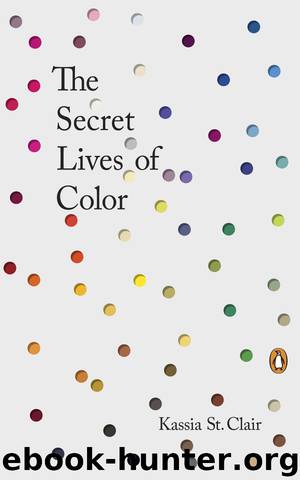The Secret Lives of Color by Kassia St. Clair

Author:Kassia St. Clair
Language: eng
Format: epub
Publisher: Penguin Books
Published: 2017-10-24T04:00:00+00:00
Egyptian blue
William, a small ceramic statuette of a hippopotamus, can now be found in the Metropolitan Museum of Art, around 6,000 miles and some 3,500 years away from his point of origin: the banks of the Nile in Egypt. Although to our eyes he cuts rather a beautiful figure, with his blue-green glazed skin decorated with flowers, to his creators he would have seemed far less benevolent. Hippos were dangerous creatures, both in real life and in mythology, where they might upset your journey to the underworld. Figurines like this had their legs broken (William’s have subsequently been repaired) and were placed in tombs as talismans to protect their occupants on their onward journeys.
The Egyptians were uncommon in valuing blue: most Western cultures didn’t even possess a separate word for the slice of spectrum between green and violet. For the ancient Egyptians, though, the color represented the sky, the Nile River, creation, and divinity. Amun-Ra, the empire’s principal deity, was often depicted with blue skin or hair, a trait that other gods borrowed from time to time too. The color was thought to dispel evil and bring prosperity, and was much sought after in the form of beads, which in themselves were believed to possess magical protective qualities.1 Although the Egyptians also used and valued other blues, including turquoise and azurite, both had their disadvantages: the former because it was rare and expensive, the latter because it was hard to carve. So from the time Egyptian blue was first manufactured, sometime around 2500 B.C., it was put to frequent use. Scribes wrote with it on papyri and it has also been found making up hieroglyphics on walls, used as a glaze on funerary objects, and decorating coffins.2
It was the Romans who first referred to the pigment as “Egyptian blue”; the originators themselves called it, simply, iryt (artificial) hsbd (lapis lazuli).3 Its chemical name is calcium copper silicate, and the raw ingredients used in its manufacture were chalk or limestone; a copper-containing mineral, such as malachite, which gave it the blue color; and sand. These were likely fired together between 1,742 and 1,832°F, to create a brittle, glassy solid that was ground down and then refired at between 1,562 and 1,742°F to produce an intense blue that was long-lasting and versatile.4 Not only was it resistant to alkalis and acids but it also lasted well in strong light. Depending on how finely it was ground, it could be as dark as lapis lazuli or as pale as turquoise; if it was applied over a dark base layer it could be almost electric. Producing it was an extraordinary technical challenge. Not only did the ingredients need to be fired together at precise temperatures; the oxygen levels needed to be regulated too.
Mysteriously, given the existence of texts describing it, the manufacture of Egyptian blue petered out.5 Examples from the thirteenth century have been found in Italy, but it is believed this was due to reuse of old pigment stock—small balls of Egyptian blue are often found in Roman excavations.
Download
This site does not store any files on its server. We only index and link to content provided by other sites. Please contact the content providers to delete copyright contents if any and email us, we'll remove relevant links or contents immediately.
Wonder by R.J. Palacio(8432)
Mastering Adobe Animate 2023 - Third Edition by Joseph Labrecque(3722)
Unlabel: Selling You Without Selling Out by Marc Ecko(3575)
Ogilvy on Advertising by David Ogilvy(3486)
Hidden Persuasion: 33 psychological influence techniques in advertising by Marc Andrews & Matthijs van Leeuwen & Rick van Baaren(3456)
Drawing Cutting Edge Anatomy by Christopher Hart(3440)
The Pixar Touch by David A. Price(3349)
POP by Steven Heller(3298)
The Code Book by Simon Singh(3058)
The Art of War Visualized by Jessica Hagy(2932)
Slugfest by Reed Tucker(2924)
The Curated Closet by Anuschka Rees(2899)
Rapid Viz: A New Method for the Rapid Visualization of Ideas by Kurt Hanks & Larry Belliston(2816)
Stacked Decks by The Rotenberg Collection(2796)
365 Days of Wonder by R.J. Palacio(2739)
The Wardrobe Wakeup by Lois Joy Johnson(2720)
Keep Going by Austin Kleon(2683)
Tattoo Art by Doralba Picerno(2585)
Tell Me More by Kelly Corrigan(2579)
